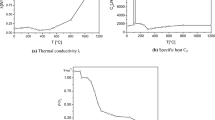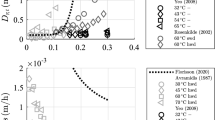Abstract
The paper describes a method for computational assessment of the long-term performance of timber beams in variable climates. The method is based on a cross-section analysis, in which the moisture content and longitudinal stress-strain distributions are calculated as function of time and ambient conditions assuming asymmetrical mechanical behaviour in the tension and compression sides of the beam. The method is implemented as a non-linear FE-program, which combines the moisture transport and structural analysis, which is based on a non-linear model of longitudinal creep in wood. The calculated stress-strain state is monitored against a failure criterion, which is based on a definition of a local damage variable and on its integration over the volume in the fashion of the Weibull theory of weakest link to give a global damage parameter. Computational results include long-term deformation (eflection) and time-to-failure (long-term capacity) predictions. Examples of time-to-failure calculation are given.
Résumé
Ce papier présente une méthode d'évaluation des calculs de la performance à long terme des poutres en bois dans des conditions climatiques variables. La méthode est basée sur une analyse transversale, selon laquelle la teneur et les données de distribution longitudinale contrainte-déformation sont calculées en fonction du temps et des conditions environmenantes, prenant pour hypothèses un comportement mécanique asymétrique sur les côtés en tension et compression de la poutre. La méthode est appliquée selon un programme nonlinéaire d'éléments finis, qui associe les données de transport d'humidité et l'analyse structurelle basée sur un modèle nonlinéaire de fluage longitudinal dans le bois. Le calcul de la contrainte-déformation est confronté à un critère de rupture basé sur une définition d'une variable d'endommagement local et sur son intégration sur le volume, conformément à la théorie de Weibull du line le plus faible pour foumir un paramètre d'endommagement. Les résultats des calculs comportent les prévisions de la déformation sur le long terme (flexion) et des délais de rupture (capacités sur le long terme). Des exemples de délais de rupture sont fournis.
Similar content being viewed by others
References
Grossman, P. U. A., ‘Requirements for a model that exhibits mechano-sorptive behaviour’,Wood Science and Technology 10 (1976) 163–168.
Hanhijärvi, A., ‘Modelling of creep deformation mechanisms in wood’, (Technical Research Centre of Finland, Espoo, FI, VTT Publications 231, 1995).
Hanhijärvi, A., ‘Deformation kinetics based rheological model for the time-dependent and moisture induced deformation of wood’,Wood Sci. Tech. 29 (1995) 191–199.
Hanhijärvi, A., ‘Development of a computational method for analysis of the strength reduction of LVL-beams due to longterm loading and variable environment’, Proc. COST E8 Int. Conf. on Wood-Water Relations, Copenhagen, 16–17 June 1997 (Tech. Univ. of Denmark, Dept. Structural Engineering and Materials, 1997) 437–450.
Hanhijärvi, A., Galimard, P. and Hoffmeyer, P., ‘Duration of load behaviour of different sized straight timber beams subjected to bending in variable climate’,Holz als Roh-und Werkstoff 56 (5) (1998) 285–293.
Toratti, T., ‘Creep of timber beams in a variable environment’, (Helsinki University of Technology, Lab. of Structural Engineering and Building Physics, Report 31, 1992).
Mårtensson, A., ‘Mechanical behaviour of wood exposed to humidity variations’, (Lund University, Department of Structural Engineering, Report TVBK-1006, 1992).
Barrett, J. D. and Foschi, R. O., ‘Duration of load and probability of failure in wood. Part I: Modelling creep rupture’,Canadian J. of Civil Engineering 5 (4) (1978) 505–514.
Gerhards, C. C., ‘Time related effects on wood strength: A linear-cumulative damage theory’,Wood Science 11 (3) (1979) 139–144.
Gerhards, C. C. and Link, C. L., ‘A cumulative damage model to predict load duration characteristics of lumber’,Wood and Fiber Science 19 (2) (1987) 147–164.
Foschi, R. O. and Yao, Z. C., ‘Another look at three duration of load models’, Proc. of XVII IUFRO Congress, Paper No. 19-9-1 (International Union of Forestry Research Organisations, 1986).
Fridley, K., Tang, R. C. and Soltis, L. A., ‘Hygrothermal effects on load-duration behaviour of structural lumber’,Journal of Structural Engineering 118 (4) (1992) 1023–1038.
Fridley, K., Tang, R. C. and Soltis, L. A., ‘Load-duration effects in structural lumber: strain energy approach’,Ibid. 118 (9) (1992) 2351–2369.
Morlier, P., Valentin, G. and Toratti, T., ‘Review of the theories on long term strength and time to failure’, In Gowda, S. S. (Ed.) Proc. COST 508 Wood Mechanics Workshop on service life assessment of wooden structures, Technical Research Centre of Finland, Espoo, Finland, 18–19 May 1994 (European Commission, Luxembourg, 1996).
Krausz, A. S. and Eyring, H. ‘Deformation kinetics’, (John Wiley & Sons, New York, 1971).
Hoffmeyer, P., ‘Failure of wood as influenced by moisture and duration of load’, (State University of New York, College of Environmental Science and Forestry, Syracuse, NY, 1990).
Hanhijärvi, A. and Ranta-Maunus, A. ‘Computational analysis of factors affecting the bending DOL behaviour of LVL’, Proc. COST Action 508 Wood Mechanics Workshop on Mechanical Properties of Panel Products, BRE, Watford, UK, 22–23 March, 1995 (European Commission, Luxembourg, 1996) 141–152.
Rouger, F. ‘Volume and stress distribution effects’, In Blass, H. J., Aune, P., Choo, P. S., Görlacher, R., Griffiths, D. R., Hilson, B. O., Racher, B. and Steck, G. ‘Timber Engineering STEP 1. Basis of design material properties, structural components and joints’ (Almere, Centrum Hout, The Netherlands, 1995).
Fonselius, M., ‘Effect of size on the bending strength of laminated veneer lumber’,Wood Sci. Tech 31 (1997) 399–413.
Hanhijärvi, A. and Ranta-Maunus, A., ‘Computational analysis of the effect of transverse anisotropy and annual ring pattern in cross-sections of curved glulam beams on the size effect of strength’, European Workshop on Application of Statistics and Probabilities in Wood Mechanics. Bordeaux, Feb. 22–23, 1996. (In press).
Zienkiewicz, O. C., ‘The finite element method’, 3rd Edn. (McGraw-Hill, London, 1977).
Wood, L. W., ‘Behaviour of wood under continued loading’,Engineering News-Record 139 (1947).
Wood, L. W., ‘Relation of strength of wood to duration of stress’, (U.S. Forest Products Laboratory, Report No. 1916, 1951).
Author information
Authors and Affiliations
Additional information
Dr Antti Hanhijärvi works at VTT, a RILEM Titular Member. He was the RILEM Robert L'Hermite Medallist in 1999.
Rights and permissions
About this article
Cite this article
Hanhijärvi, A. Computational method for predicting the long-term performance of timber beams in variable climates. Mat. Struct. 33, 127–134 (2000). https://doi.org/10.1007/BF02484167
Received:
Accepted:
Issue Date:
DOI: https://doi.org/10.1007/BF02484167




